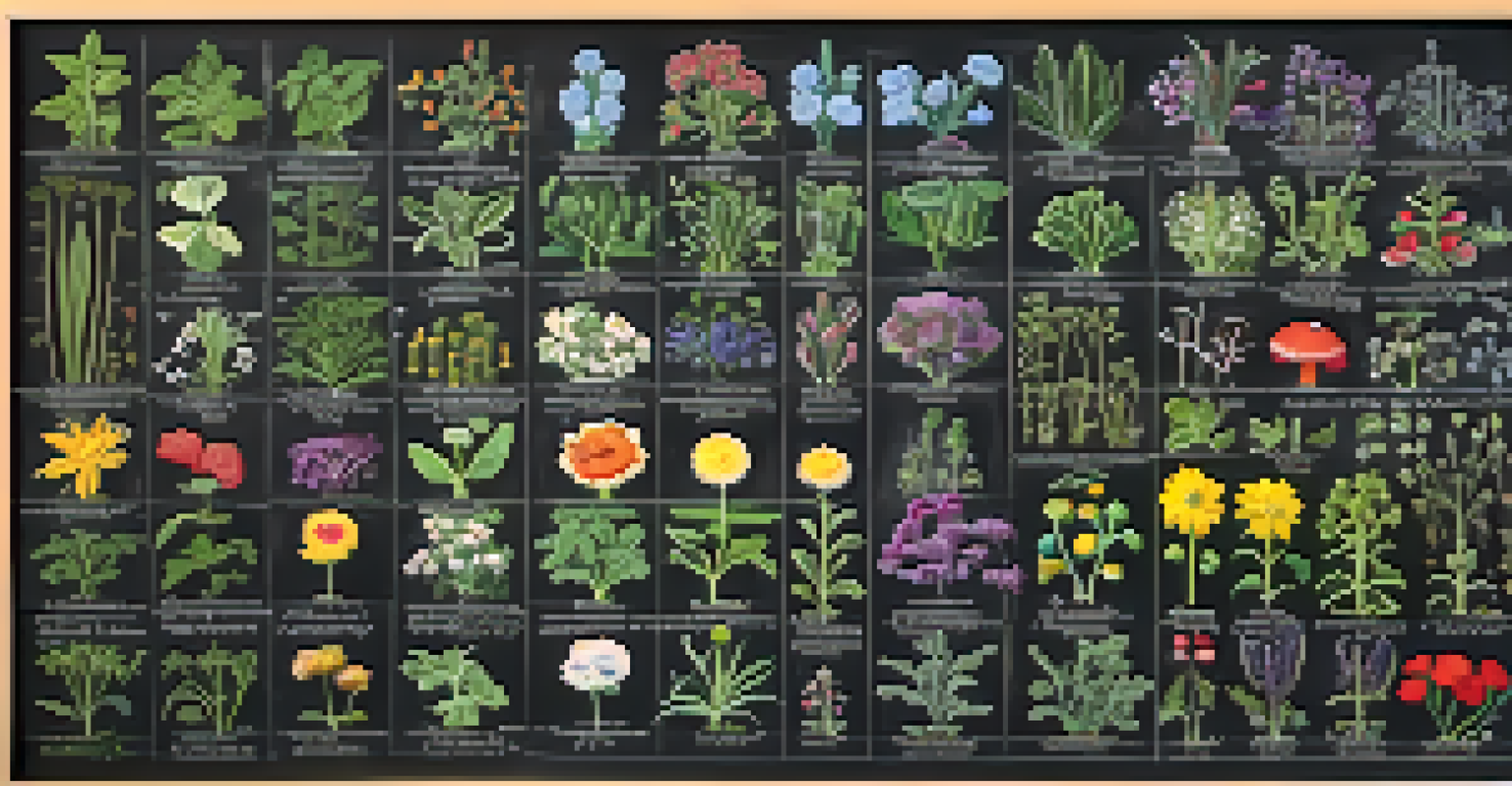The Basics of Mendelian Genetics in Plant Breeding Practices

What Is Mendelian Genetics?
Mendelian genetics is the study of how traits are inherited from one generation to the next. It was founded by Gregor Mendel, who conducted experiments with pea plants in the 19th century. Through his work, he discovered fundamental principles like dominant and recessive traits, which are crucial for understanding heredity.
Genetics is not just a science; it is a way of understanding the world around us, revealing the intricate connections between organisms and their traits.
Mendel's laws of inheritance—specifically, the Law of Segregation and the Law of Independent Assortment—establish how alleles, or gene variants, are passed down. This information is invaluable for plant breeders looking to cultivate specific characteristics in crops. By knowing which traits are inherited together, breeders can make informed decisions about their breeding programs.
In essence, Mendelian genetics provides a framework for predicting how traits will appear in future generations. This predictability is what makes it a cornerstone of plant breeding, allowing for the systematic development of new varieties that meet agricultural needs.
The Role of Alleles in Plant Traits
Alleles are different forms of a gene that can produce variations in traits. For instance, in plants, one allele might produce red flowers while another produces white flowers. When plants are bred, the combination of alleles from both parent plants determines the traits of the offspring.

In practice, understanding alleles helps breeders select parent plants that will produce the desired characteristics in their crops. For example, if a breeder wants to create a variety with drought resistance, they can choose parent plants known to carry alleles associated with this trait. This targeted approach increases the chances of success in developing new varieties.
Mendelian Genetics Basics
Mendelian genetics explains how traits are inherited through dominant and recessive alleles, forming the foundation of plant breeding.
Additionally, the interaction between multiple alleles can lead to a range of traits, known as polygenic inheritance. This complexity underscores the importance of careful planning in breeding programs, as it can influence everything from yield to disease resistance.
Dominant and Recessive Traits Explained
In the world of genetics, traits are often categorized as dominant or recessive. Dominant traits are those that will manifest in the offspring even if only one parent contributes the corresponding allele. In contrast, recessive traits require both alleles to be present for the trait to appear.
The future belongs to those who understand the genetic blueprint of life, allowing us to create solutions for food security and sustainability.
For example, if a plant has one allele for purple flowers (dominant) and one for white flowers (recessive), the flowers will be purple. This principle allows breeders to predict how traits will be expressed in new plants based on the genetic makeup of the parents. Knowing which traits are dominant helps in crafting specific breeding goals.
Understanding dominant and recessive traits is essential for plant breeders, as it influences their strategies for developing new varieties. By selecting parent plants with desirable dominant traits, breeders can quickly achieve their breeding objectives.
Punnett Squares: A Breeder's Tool
Punnett squares are simple diagrams used to predict the genetic makeup of offspring from two parent plants. By mapping out the alleles from each parent, breeders can visualize potential trait combinations in the next generation. This tool makes it easier to understand the probabilities of inheriting certain traits.
For instance, a 2x2 Punnett square can show the possible combinations of alleles for a single trait. If both parent plants are heterozygous for a trait, the square helps illustrate that there’s a 25% chance the offspring will inherit the recessive trait. This predictive power is invaluable for breeders aiming to attain specific outcomes.
Role of Alleles in Breeding
Understanding alleles allows breeders to select parent plants strategically to achieve desired traits, such as drought resistance.
Using Punnett squares not only aids in planning breeding strategies but also serves as an educational tool for understanding genetic principles. As breeders refine their techniques, the Punnett square remains a classic method for visualizing genetic probabilities.
Linking Mendelian Genetics to Plant Breeding
Mendelian genetics is not just a theoretical framework; it directly influences modern plant breeding practices. By applying Mendel's principles, breeders can create new plant varieties that meet specific agricultural demands, such as higher yields, pest resistance, or improved nutritional content. This connection underscores the practicality of genetic research.
For example, breeders often cross plants with known desirable traits to create hybrids that combine those traits. Understanding the underlying genetic mechanisms allows for more precise breeding, ultimately leading to more successful outcomes. This scientific approach has revolutionized agriculture.
Moreover, as technology advances, the integration of Mendelian genetics with molecular breeding techniques provides even more tools for plant breeders. This synergy can enhance breeding efficiency and effectiveness, paving the way for innovative solutions to global food challenges.
Challenges in Applying Mendelian Genetics
While Mendelian genetics provides a foundation for plant breeding, it is not without its challenges. One major hurdle is the complexity of traits that are influenced by multiple genes, known as quantitative traits. These traits do not follow simple dominant-recessive patterns, making predictions more complicated.
Additionally, environmental factors can also affect how traits are expressed, leading to unexpected results in breeding programs. For instance, a plant may exhibit different characteristics depending on soil type, climate, or other growing conditions. This variability means that breeders must consider both genetic and environmental factors in their strategies.
Future of Plant Breeding
Advancements in technology, like CRISPR, are set to enhance plant breeding by integrating Mendelian genetics with modern techniques.
Navigating these challenges requires a combination of experience, knowledge, and adaptability. Successful breeders often employ a variety of breeding techniques, including both traditional and modern methods, to address the complexities associated with Mendelian genetics.
The Future of Plant Breeding and Genetics
As we look to the future, the role of Mendelian genetics in plant breeding is likely to evolve with ongoing advancements in technology. Techniques like CRISPR gene editing are already enhancing our ability to manipulate genetic traits with precision. This could lead to the development of new varieties that are faster, more efficient, and tailored to specific agricultural challenges.
Moreover, the integration of genomic data with traditional breeding practices allows for a more nuanced understanding of how traits are inherited and expressed. This holistic approach can significantly improve the outcomes of breeding programs, leading to more resilient crops that can thrive in changing climates.

Ultimately, the future of plant breeding will continue to be rooted in Mendelian genetics, but it will also embrace new technologies. This blend of traditional principles with innovative methods holds the promise of addressing global food security challenges in the years to come.